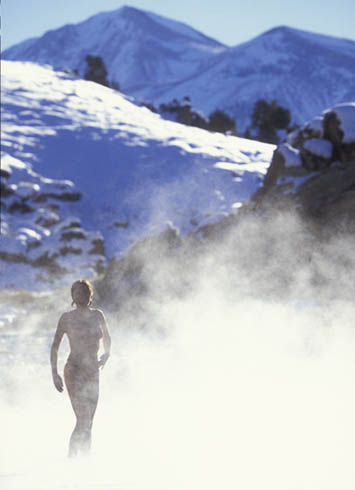|
Mammoth Monthly April 2004 Hot Creek on a Cold Day
By Suzanne Hurt Early morning cold licks our cheeks with the tenderness of a hungry coyote. We snap into cross-country skis and hit the snow for a cold pilgrimage to the hot springs known as Hot Creek. Snowmobilers, hikers, skiers and snowshoers have made competing tracks through the frosty terrain. Monster tire tracks turn the road into a sufferfest. We lay skinny tracks on the roadside where we can. Mostly we slog from ski track to ruts to fresh snow quickly interrupted by momboosa ruts. We find nice tracks and get in the zone, only to crater into an impassable hollow carved out by a tire. It's not the backcountry. But it is the way into the hot springs. We loosely follow Mammoth Creek, here a sinuous landing zone for herons and ducks. Sparkling hoarfrost crystals turn Long Valley into a field of diamonds. We were told crowds have overrun Hot Creek. Crowds and disrespect for sacred natural areas turns off some, including indigenous people. But the only other person out here is wildlife biologist Denyse Racine, who's skiing to survey bald eagles. She's lived in Bishop 16 years. "I've never gone in the creek because I've heard too many horror stories," she says. We ski a couple miles, hide our skis and head down a narrow path. Mist rises off Hot Creek. Steam vents out of rocks. The dark creek percolates in a few spots like a thick soup simmering in a cauldron. The hydrogen sulfide stench grows. A thick column of gray steam rolls at least 100 feet into the air. It's easy to see the steam as malevolent. Half a dozen signs warn "Danger. Scalding Water. Unstable Ground. Keep Out." The creek sits in
an ancient caldera left when an enormous volcano erupted like killer sex
760,000 years ago. Hot Creek is a place where Mother
Earth relieves internal pressure and heat more or less gradually, its fissures
venting warm water to the surface. People get nervous talking about it, but the volcanic system is far from dead. Scientists monitor the activity closely. It's been quiet since 1998, says Chris Farrar, a U.S. Geological Survey geologist. The phenomena that create Hot Creek start four to
five miles below the earth's surface, where water
is heated by superhot rock or magma. Hot water and steam flow for miles under the valley floor, escaping through two main
faults. At Hot Creek, several thermal springs bubble out of the streambed and
mix with icy Mammoth Creek. If the volcanic system were dead, there'd be no Hot Creek. And no fraidy cats on the bank looking for a way in. Another couple snowshoes down. Organic veggie growers Barb and David Perkins came from Wisconsin to sample hot springs. We talk about the cauldron. Water even boils just beneath the ground. Just when we can't freak each other out any more, another couple walks past and disappears. Linda and David Chun change behind rocks. They walk into a large pool. I watch skeptically, but they don't sink in a frothing mass of skin and bones. "It's warm. So nice," he says. I slip into the steaming water next to Linda and find the adorable Burbank couple has trekked to Hot Creek since 1988. "This is healing water," she says, running water over her arms. "Very good for you. It makes your skin like a baby's. It heals everything: Dandruff. Athlete's foot. We brought my friend. She had a problem with her leg. She walked here with a cane. Her husband carried her down on his back. She sat in here three hours. She walked out." I like the sound
of that. The Perkins follow us in. A fourth couple comes: Mary Schnurer, 38, of
Lake Forest and Ross Anderson, 38, of Oceanside. Soon seven of us are stretched
out in a half moon around a natural cauldron. Agua
caliente literally boils out of the ground a few feet
away. Hot liquid blasts are followed by cool swirls from Mammoth Creek. Steam
floats around us. Signs warn the springs carry high levels of arsenic, boron, chloride and lithium. The Chuns convince us the water is good for our skin. We rub sand and water all over. The water is only dangerous if you drink it. More dangerous is the potential for non-swimmers to be drawn into a bubbling vent to cook or drown. The ground rumbles there. "It sounds like magma could explode underneath us any time," I say. "It could," Dave says, relaxing into the sand. "If it's our time, we'll go," Ross says without concern. We gel for two hours. People slowly leave. Afternoon's fading when three dudes in shorts show up with a backpack full of snow and beer. Mammoth Lakes snowboarder Greg Frayo, 22, leads J. Thompson and Ian Joachim in with beer and smiles after a day on Mammoth Mountain. The guys chatter in that stream-of-consciousness way you get still high on sports adrenaline. They take turns making beer runs to the backpack. One of the dudes sees if his Bud will float and says, "Someone should invent a beer catamaran. So you can just set your beer in the water and relax." Two more apres-ski groups straggle in. Temperatures dive and we leave. We'll hit every momboosa rut in the dark, but we no longer care. |
